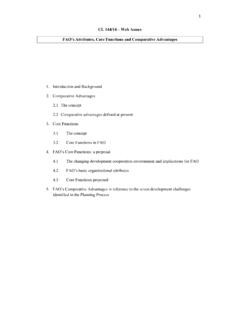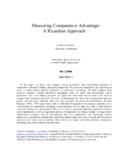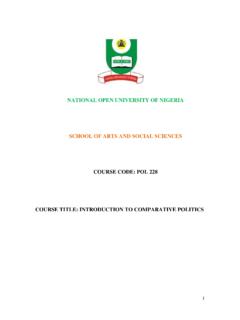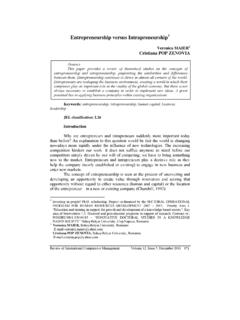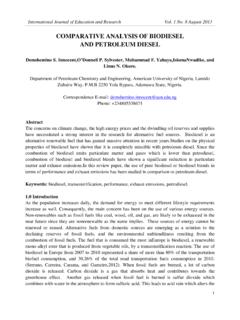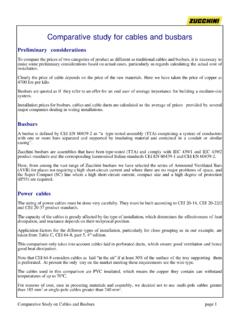Transcription of TRADE AND CUSTOMS SERVICES Comparative …
1 One effective way of achieving both supply chain efficiency and cost savings is by implementing a Free TRADE Zone, or Foreign TRADE Zone (collectively, FTZ), at a company s distribution or manufacturing facility location. Historically available in most countries around the world, FTZs are some of the most beneficial, yet underutilized regimes for realizing saving on duties, taxes, and other costs involved with global TRADE . What is more, FTZs are by no means a program used exclusively in one country, such as the United States. In fact, because most countries have FTZ programs, companies may use FTZs (or similarly designated areas) in various global locations to attain all or some of the primary FTZ benefits listed below: Duty Deferral Import duties for imports shipped to an FTZ are deferred until the time those products leave the FTZ and enter countries commerce. Duty Exemption Import duties are exempted for imports entering an FTZ and later exported without ever entering countries commerce or destroyed within the FTZ.
2 Duty Reduction (Inverted Tariff) Importers who import raw materials and conduct manufacturing operations in an FTZ may elect to pay duties for imported raw material based on the duty rate of the manufactured item (when the duty rate for the item is lower than the raw material duty rate) at the time the manufactured product leaves the zone and enters countries commerce. While these are the primary benefits of operating in an FTZ in most countries, particular countries may provide additional incentives and may have different requirements for the use of FTZs. Highlighted as follows are the benefits of FTZ programs in a few key countries, where many companies today concentrate manufac-turing, assembly, or distribution operations. Comparative Review of Select Free TRADE Zones around the WorldTAXTRADE AND CUSTOMS SERVICESIn today s economy, companies are looking for opportunities to improve efficiency and increase bottom-line savings.
3 Just a little over a year ago, these companies continued on their path to becoming evermore global and tapping into the benefits of global supply chains. Today they need to look globally for efficiency and cost and logistics expenses relating to the import and export of finished goods and raw materials, which have been generally considered to be unavoidable costs of doing business, are now coming under closer scrutiny. In today s world of global supply chain operations, where goods are sourced, manufactured, and sold in multiple countries, companies need to establish comprehensive saving strategies encompassing not only import-export operations in the United States but also abroad. 2009 KPMG LLP, a limited liability partnership and a member firm of the KPMG network of independent member firms affiliated with KPMG International, a Swiss cooperative. All rights reserved. 2 Comparative Review of Select Free TRADE Zones around the WorldUnited StatesIn the United States, an FTZ is a secure area located in or near a port of entry that is considered outside the CUSTOMS and Border Protection (CBP) territory.
4 Companies may also designate their own manufacturing or distribution centers as an FTZ anywhere in the United States and Puerto Rico. There are currently more than 260 such areas designated as FTZs, which offer SERVICES to more than 2,500 FTZ users nationally. The designation of an FTZ requires application to the Foreign TRADE Zones Board and subsequent implementation of policies, procedures, and systems. In addition to duty deferral, exemption, and reduction benefits, FTZs in the United States also offer the following incentives: Zone-to-Zone Transfers A vendor located at one FTZ may sell goods to a company in another FTZ and/or transfer those goods to the purchasing company s FTZ with no import duty paid on the goods. No Duty on Value Added When manufacturing operations are performed within an FTZ, no duties are assessed on domestic parts, materials, labor, and profit. Reduction on Broker and Processing Fees Because importers using FTZs are allowed to file weekly CUSTOMS entries, transaction costs relating to broker and merchandise processing fees are also reduced.
5 Exemption of Inventory Taxes Inventory maintained within an FTZ is exempt from personal property taxes in states where this tax is applicable. Enhanced Processes Because the running of an FTZ requires strict inventory controls, processes around these controls often lead to increased security, CBP compliance, and supply chain improvements. One primary supply chain enhancement is the ability to import products under direct delivery procedures; imported items are not subject to CBP approval until after the product arrives in the FTZ, reducing the likelihood of cargo delays from CBP inspections at the port of candidates for using FTZs are importers with high transaction volume that can take advantage of the weekly entry benefit ; importers that perform significant manufacturing or assembly in which the finished product has a lower duty rate than the duty rate of the imported materials; industry segments where importing is critical, including footwear, apparel, electronics, chemical, automotive, component subassemblies, and petroleum; and companies that want to shift operations to, or continue them in, the United States and defer, reduce, or eliminate CUSTOMS duties and fees payments on imported goods.
6 2009 KPMG LLP, a limited liability partnership and a member firm of the KPMG network of independent member firms affiliated with KPMG International, a Swiss cooperative. All rights reserved. Comparative Review of Select Free TRADE Zones around the World 3 European Union Companies operating distribution or manufacturing facilities may also greatly benefit from the various types of FTZ regimes available in the 27 countries of the European Union (EU). A primary FTZ program, called Processing under CUSTOMS Control (PCC), is an arrangement within the EU similar to the FTZ concept. This regime is provided for in Council Regulation (EEC) 2913/92 establishing the Community CUSTOMS Code and in Commission Regulation (EEC) 2454/93. Similarly, import value added tax (VAT) relief is provided for in the EU VAT is these regulations that allow importers to place goods under PCC arrangements for further processing within the EU and to pay a lower amount of CUSTOMS duty based on the same inverted tariff rule executed in the United States.
7 However, in determining whether this regime is suitable for a company s operations, it is important to note that when the goods are discharged from PCC, their value is deemed to be the CUSTOMS value of the goods entered into PCC plus the value of any other materials added, labor costs, and other directly attributable overheads. Therefore, the applicant will need to calculate whether the charges due on this increased value albeit at a lower rate exceed those that would have been due on the imported goods of operating under PCC not only include the potential lower duty rate, but also the temporary suspension of VAT, agricultural levies, and other Common Agricultural Policy is available for businesses established within the EU; however, use of this regime requires prior authorization from the local CUSTOMS authorities. There are several different types of authorizations ( , local, community, simplified, or integrated) that a company may apply for depending on your requirements and operating cases where exceptional circumstances can be proven, retrospective approvals can be obtained to allow importers to reclaim duties paid during the approved period.
8 The European Court of Justice has defined exceptional circumstances to be those that although not unknown to the trader are not events which would normally confront any trader in the exercise of his business or circumstances which are liable to put the applicant in an exceptional situation in relation to other traders carrying on the same activity. 1 In addition, importers applying for retrospective approval must also demonstrate there has been no obvious See R1-5 Outward Processing Relief guidance at operating distribution or manufacturing facilities may also greatly benefit from the various types of FTZ regimes available in the 27 countries of the European Union (EU). 2009 KPMG LLP, a limited liability partnership and a member firm of the KPMG network of independent member firms affiliated with KPMG International, a Swiss cooperative. All rights reserved. 4 Comparative Review of Select Free TRADE Zones around the WorldMexicoChanges in Mexico s CUSTOMS regulations in recent years have greatly expanded FTZ-like programs beyond conventional Maquila operations previously available to importers.
9 The Strategic Private Bonded Warehouse program (the REFIE) has existed since 2003 with benefits similar to those of the FTZs and the EU PCC program. Under REFIE, goods and raw materials may enter approved sites (these can be private warehouses or warehouses run by state governments) with the deferral of import duties and other taxes. Once within the REFIE, goods may undergo manufacturing, assembly, or other value added SERVICES without the payment of duties and key benefit under Mexico s new FTZ law is that, when a company is ready to withdraw finished merchandise from the FTZ, taxes are paid only if the merchandise will be released into local commerce. If the merchandise will be shipped to the United States or other foreign markets, the merchandise may leave Mexico without incurring CUSTOMS duties or a pure distribution REFIE environment (as opposed to one that would involve manufacturing or assembly operations), merchandise from abroad may be deconsolidated and inspected and, in some cases, the company may conduct repair, repackaging, labeling, and marking activities to prepare the goods for final sale.
10 For products shipped out of the REFIE, Mexican duty is eliminated entirely. Merchandise returned to vendors, waste, and products destroyed within the FTZ may also enjoy duty elimination benefits in regime also affords attractive tax advantages. The main benefit consists of exemption of the VAT triggered by sales of goods subject to the REFIE regime. As it relates to income tax, REFIE locations are not deemed to be a permanent establishment for foreign parent companies and, therefore, reductions or exemptions for income taxes may be allowed for activities performed within the 2007, Mexico s state government entities have been authorized to administer REFIEs. When dealing with a REFIE that is administered by a state government, the likelihood of obtaining additional tax incentives ( , payroll tax exemption or property tax exemptions) increases, since the company may negotiate these types of incentives directly with the state when establishing the key benefit under Mexico s new FTZ law is that, when a company is ready to withdraw finished merchandise from the FTZ, taxes are paid only if the merchandise will be released into local commerce.
